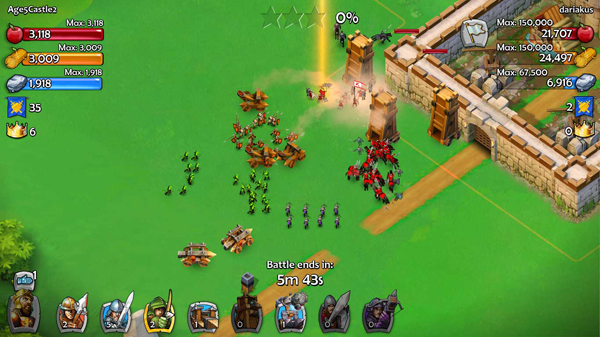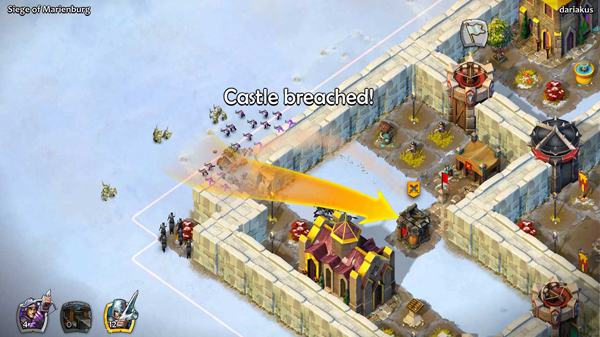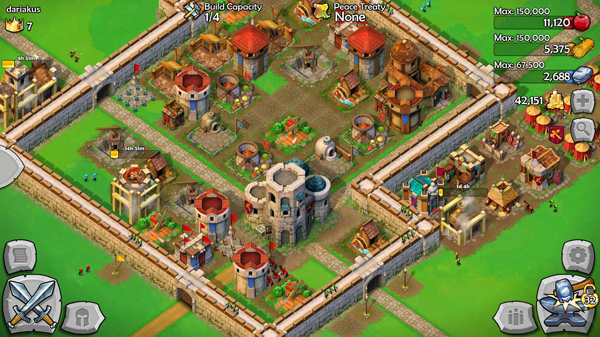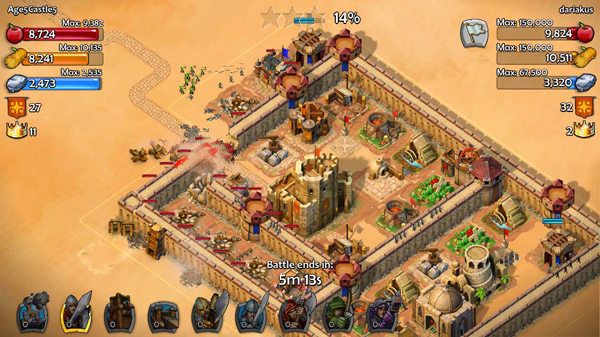Tom's Guide Verdict
In Age of Empires: Castle Siege, the most compelling choice you'll make is whether to waste your money or your time.
Pros
- +
Gorgeous graphics and art style
- +
No bugs or glitches
Cons
- -
Very little real gameplay
- -
Everything is a microtransaction
- -
Mostly just waiting around
- -
Forgettable music
- -
Dishonors series legacy
Why you can trust Tom's Guide
Since its debut in 1997, the Age of Empires series has excelled in offering players compelling choices. As you took command of history's greatest civilizations, you could choose to control the praetorian might of Rome, the structural grandeur of Byzantium or the relentless tenacity of the Sioux.
You could raze your enemies' strongholds to the ground, corner the global economy or build a wonder to last through the ages. You could amass a horde of cavalry archers to sweep across the Mongolian steppes, train a battalion of war elephants to trample your foes or launch an unstoppable navy to lay low the great cities of the Holy Land.
In the newly released Age of Empires: Castle Siege, the most compelling choice you'll make is whether you want to waste your money or your time.
In theory, Castle Siege is developer Smoking Gun Interactive's attempt to bring the inimitable Age of Empires franchise to a Clash of Clans-style mobile game. The result is enough to make any longtime series fan weep. Not only is the game little more than a delivery vessel for microtransactions, but it also manages to eschew almost everything that has delighted series fans for the last 17 years.

Gameplay
Castle Siege isn't something you play so much as it's something you throw money at over and over, hoping against hope for a brief, shining moment of gameplay. Perhaps there is a real game lurking somewhere beneath Castle Siege's admittedly attractive exterior, but if so, the only amusement to be had is on Microsoft's end. The company publishes the game and owns the rights to the series, and it looks as if it is seeing how much money it can milk out of trusting fans who deserved better.
MORE: 15 Fun Facebook Games
To be fair, the game looks a lot like a traditional Age of Empires experience, at first blush. You start with a limited number of resources (food and wood) and construct mills and farms in order to gather more. When you get enough resources, you can build military structures and recruit an army to wage war on enemy towns. Earn enough resources, and you can bring your civilization into the next Age, which gives you access to new buildings, new technology and new types of soldiers.
Get instant access to breaking news, the hottest reviews, great deals and helpful tips.
So far, so good, but remember, this is not a traditional real-time strategy game: This is a free-to-play title. That means that everything you do takes time — and not the few seconds to a minute that buildings and units usually required in previous installments. As you get past the tutorial phase ofCastle Siege, training units takes three to five minutes. Upgrading a building might take half an hour. Constructing a whole new building can take up to a day — and of course, you can only construct or upgrade four buildings at a time.

If you're wondering why the game places such draconian restrictions on the fun bits, the answer is simple: to make money. You need to pay to get ahead more quickly.
Complaining about microtransactions in a free-to-play game is always tricky, since making games is costly and the developers have to recoup their expenses somehow. Still, there are good and bad ways to ask players for money, and Castle Siege has some of the most manipulative schemes I've ever encountered.
In addition to food, wood and (later on) stone, there's one more resource to collect: gold. While you can earn a paltry amount by making war with other players or constructing roads, the best way to get gold is to fork over your real-world valuables to Microsoft.
Gold is the game's all-purpose "speed-up" currency, and gold microtransactions are attached to literally everything in the game. Want to finish building that cathedral before Islamic warriors sweep across the Middle East? Fork over some cash. Need some food and wood to meet the game's exorbitant resource requirements for structural upgrades? That'll cost you some gold. Require an army sometime before the soldiers are ready for veterans’ benefits? Pay up.
To give you an idea of how quickly the game encourages you to cough up dough, I had about $10 of gold provided by Microsoft to help me review the game. While building up my city in the game's middle stages, I spent every last coin within 15 minutes. It was either that or wait approximately two days for everything to finish.

Military Unintelligence
Remember that bit about needing soldiers? Well, you're going to need them, and you're going to need them more often than ever before. Castle Siege resets your army to zero after every single battle — even if your Napoleonic tactical brilliance spared the life of every swordsman, archer and siege engineer under your command. One must assume that in the world of Castle Siege, soldiers are highly excitable and, like Sherlock Holmes without a mystery to solve or enough cocaine to subdue a bull hippopotamus, spontaneously combust outside of combat.
This makes building an army a joyless, monotonous task rather than a strategic pleasure. After all, what's the point of building a well-balanced attack force and directing each unit with meticulous precision when a victory-by-numbers suicide charge works just as well with just as much (or more accurately, just as little) reward?
Even when you get into battles, there's not much fun to be had. Units move and attack automatically, and never work with any kind of cooperative instincts. Unless you micromanage every single squad, expect your axemen to engage in a suicidal charge against a castle while your swordsmen destroy a particularly menacing farm and your crossbowmen cheerfully stand around getting mowed down by cavalry.

There are two ways to fight: skirmishes against other players and campaign missions, of which there are a whopping 10. Fighting other players is a way to earn resources, but it's not a particularly good way. As previously stated, soldiers are good for one use only, and when you raid other players, you'll just about break even — at best. To add insult to injury, even finding other players to fight costs resources, and the expense increases as your city grows.
Rather than real-time battles, multiplayer in Castle Siege is asynchronous. Players set up their cities, complete with archer towers, soldier patrols and caltrops, and see if their structures can withstand an enemy siege. Spoiler: They usually can't. Until you reach very high levels, your defensive options are limited, and other players can take your resources and crowns (which measure how well you do in multiplayer) with relative impunity.
The campaign is also a far cry from the sweeping historical epics of previous games. You'll reenact real battles at historical locations such as Aleppo, Thessalonica and Kiev, but you'll only get one battle per civilization. This makes the campaign feel disconnected and not particularly educational.
Worse still, you don't get to design your own armies for the campaign, so if the game sends you to besiege Constantinople without any siege weapons (and it does), you'd better figure out exactly how to maneuver a small group of soldiers into the heart of the enemy castle. Given your limited, nonselectable troops, the campaign is more like a puzzle game than a strategy title, and proves more frustrating than fun.

Graphics and Art
The one shining ray of hope that pierces Castle Siege's otherwise impermeable darkness is the way it looks. Castle Siege embraces a bright, colorful, cartoony art style, and every civilization looks distinct. From the sandy deserts of the Saracens to the snow-covered plains of the Kievan Rus, there's something gorgeous to behold from every corner of the ancient world.
Likewise, the animations are about as smooth as they come, and each collection of units behaves differently. Watching a group of raiders charge toward a wall and scale it on tiny yellow ladders is as interesting as watching a group of swordsmen methodically approach a group of enemy soldiers, or a catapult lay low a whole battalion of archers. If only players could control the action with more precision.

Music and Sound
The Age of Empires series used to be synonymous with memorable soundtracks, but that's no longer the case. The music in Castle Siege is passable, but I'd be hard-pressed to hum a single tune from it — when the sound worked at all. It would frequently cut out, especially when I was managing my home city. Often, I didn't even realize it was gone.
MORE: 15 Best Windows 8 Games
The sound effects also fade into the background, and there's no voice acting to speak of. If you turn the sound off entirely, you're not missing anything.

Bottom Line
Age of Empires: Castle Siege managed to do what no previous entry in the series, however questionable, could: It broke my heart. It made me question whether Microsoft can save this series, and whether it's even worth saving.
You could spend dozens, even hundreds, of dollars and get nowhere, or you could tend to your city assiduously for weeks and weeks and end up at the same nowhere. Either way, you are spending a valuable resource in exchange for not having fun — or perhaps the slightest bit of fun, surrounded by hours upon hours of meaningless grind. It's not a good transaction.
Since the game is free, you may as well download it if it strikes your fancy, but don't expect much in the way of positive emotions. If there's one thing Age of Empires has taught us, it's that all empires eventually fall and fade into the mists of history.
This is the end of a gaming empire that spanned history from Ancient Egypt to the Sioux Wars. It met its fate, as so many historical civilizations do, due to an unquenchable lust for gold.
Specs
Publisher: Microsoft Studios
Developer: Smoking Gun Interactive
Genre: Strategy
Price: Free-to-play with microtransactions
Release Date: 9/17/14
Platforms: Windows 8, Windows Phone 8
| Our Favorite Gaming Hardware: |
| Best Gaming Mice |
| Best Gaming Desktops |
| Best Gaming Keyboards |
Marshall Honorof is a Staff Writer for Tom's Guide. Contact him at mhonorof@tomsguide.com. Follow him @marshallhonorof and on Google+. Follow us @tomsguide, on Facebook and on Google+.

Marshall Honorof was a senior editor for Tom's Guide, overseeing the site's coverage of gaming hardware and software. He comes from a science writing background, having studied paleomammalogy, biological anthropology, and the history of science and technology. After hours, you can find him practicing taekwondo or doing deep dives on classic sci-fi.
-
mikelaughs This is very close to the review I would have written after an hour of game play.Reply
However, once you get things rolling and start to learn the ropes, you will find that there is a LOT to this little game, and while I don't play it for hours and hours at a time, I always have something building or upgrading in the background, and when I do play, it's a mix of curating my defenses, technology, weapons, units, and economic machine, mixed with infiltrating and looting an endless variety of real user's castles, well not always successfully :|. Long story short, there's more to this little game than meets the eye at first. give it a little time. -
gaborbarla I agree with you, and I think All games with micro transactions should die a costly (to the publisher) death.Reply
Recently Microtransactions destroyed our hopes for dungeon keeper for the tablet http://metro.co.uk/2014/02/04/dungeon-keeper-review-microtransaction-hell-4289901/
I am very happy to purchase games on hublebundle and steam and even google play but I will never even try a game with micro transactions. It always goes overboard (becomes to costly to buy everything) and it requires my credit card details to be permanently be plugged into Big Brother to make the transactions. -
GeneralStrax I have been playing this game since its release, and I enjoy it quite a bit. Yes, if you want to get everything right away you have to pay money, but those of us familiar with this type of game are used to the idea of waiting for things to be built. It is not a PC game, you do not sit in front of it for hours making constant progress, you come back to it from time to time and play.Reply
Also, the idea that you have to pay real money for resources is just silly. I am sure that people do, and it is a huge waste of money. You can get everything you need from attacking people, and since your opponents scale up when you do, so do their available resources.
As it stands right now, without paying any money, I can come back to the game and attack another player every 20 to 30 minutes depending on what troops I want to build. I can pay $5.00 to get 500 "gold" and fill all my resource silos by 10%, or I can attack my peers one or two times, depending on how lucky I get in drawing someone with a lot of resources, and get the same number of resources.
If I were to pay money, I would just buy 500 gold and use it to speed up troop development, since I can completely max out the number of troops I have for 19 or 20 gold, giving me 25 times that I can decide that I do not want to wait, and giving me far more resources than I could ever use. As it stands now, they start you with 500 gold, you get it randomly in battles, and you "earn" it by completing tasks and objectives.
Sure, when I upgrade my "Age" from Age 5 to Age 6 it will take 2 days, but I can still play during that time, and that is what you get with this kind of game, something you check in on every now and then and have fun.
As a final note, I have paid
$0.00 on this game, yet I have been able to be successful enough in it to almost break into the top 200 players, and I am in one of the top 10 "alliances" where I am one of the top players. You do not need to pay money to win, you do not need to pay money to have fun, and heck, what does an age of empires game for the PC cost when it first comes out? $30 or $40? I am still using the gold that they give you when you sign up, and I have been playing for a couple of weeks. If I decide to pay $5.00 every now and then to get more enjoyment out of a game that I really like how am I getting ripped off?
If you want a game that you can play and advance through whenever you want, go buy the latest console game for $40 or $50. If you want a game to play every now and then that is fun and free, try this one out. It really is fun, and it really does not need to cost you money. If you hate the format, like the reviewer certainly does, fine, some people do not like side scrolling video games either, that does not mean that they are ripping you off if you buy them. -
Tom Tancredi Reading the review brought out some serious issues for myself, especially as I have and played AoE long ago, and many other strategy type games since. Given this I would as well be quite disappointed as the reviewer pointed out some of the biggest issues, but let me take a step back and say, this is a prime example of trying to kill off the PC gaming market, through bad decisions, flagrant abuse of the consumers, and most of all purposeful 'just make money' business strategies then the original "if we make it well, they will play it and make us rich" mantra of old.Reply
First the issue was the repeated I, II, III, etc. etc.game titles (ala Rocky / Rambo / Aliens / etc. worse and worse movie making ) constant 'rehash' to illicit investment yet fail to deliver a real 'same' or 'next level' experience that most of the Game Studios are constantly doing. Rather then learn the lesson of these other 'series' (Game Studios are ENTERTAINMENT Business models after all, and so are Movie Makers), and instead seek something smarter (like LoTR / The Dark Knight / etc.) to capitalized on 'better' or 'next level' than the previous edition, we instead get dunked on. We know the AoE game play, we seen all the other similar games that have been released since, and now we get ..... this???; do I now feel like Colonial Marines all over again, YEP!
Second, here is a serious problem, we know iOS has it's portable games, we all know 'Facebook' Games, we all seen Angry / Flapping / Whatever else Birds on Android devices all bring profits and some serious recognition to that platform (iPhones, Android Phones, getting on Facebook) with the special enhancement multiplayer provides (can't count how many hours of Bejeweled-like games competed across family members I seen on FB) . Now with Windows 8/Phone (which this game is made for hmmmm) and the company behind W8/Phone is also the AoE owner, and pushes out a game to do the 'same thing'??? Well the horse left the yard years ago and the barn doors collapsed with the age of the dead old barn. In other words : You missed the boat M$ and your insulting your customers.
This culminates into a game that rips out the key parts that made AoE what it was, into a terrible replacement (think Rocky V or so) to the whole point to the game. Waiting a full day to complete a building? Sitting and waiting for units to finally be trained? Oh was that the armory you needed built so you can defend against the other players? Never mind the mass suicide the writer points out (WHAT!!!) that makes no sense in the game EXCEPT to FORCE players into Pay to Play model.
Yes GeneralStrax, I get that the bills need to be paid and so on, but some facts your overlooking here. This isn't a 'independent studio' (aka couple college guys in the dorm room hammering out code over $5 pizza pies) this is a company that has NOT MADE ANY PROFIT EVER on its XBOX line (http://www.forbes.com/sites/adamhartung/2014/02/18/microsoft-should-give-xbox-one-to-nintendo/) and NEVER made any money with Internet Explorer (gave it away for free). In all fairness this studio, for the purposes I outlined, also distribute this 'free' game as a FREE Game? YES. No microtransactions, no obliterating armies when returned from combat, no obscene delays in building stuff (A full day to build one virtual building?!?! Come on). That it is gorgeous, addictive time waster (WAIT isn't those other titles I said ALSO the same way? Well almost, you had to 'buy' them to get the 'rest' of the game' unlocked) that would make W8/Phone a popular platform to enjoy gaming on.... potentially yes.. but instead...
This just further emphasizes M$ decision to abandon the Windows platform for gaming, and to authorize, support, and promote such 'pretty' crapware is further missteps (or purposeful) to kill off PC based gaming. AoE was a great 'casual' game, one could build up a bunch of stuff, then stop do other things, comeback later (especially if you had to let things build) and pick up and direct the next 'phase' of your campaign. Of course the learning curve was when to do 'comeback later' or 'shut down the game' and when not to, like the random hordes that would overwhelm a area I planned to 'next' build a wall, OOPS I cameback later and my entire city was razed to the ground and all my citizens run off! Or the famous, OOPS I forgot to change the taxes and now I have a completely empty city that even if I pay people to move back in I can't support anymore! Or the hundred of other 'learning curves' in the games.
Nope, with this crapware I easily see "Pay of DIE as Bambi food by game spoilers" whom will do nothing but seek out those not plunking down $50USD for gold to 'spin up' the needed resources, and just be the same 'meals' the writer is talking about stealing resources from. All the while these spoiler stay / obtain higher and higher levels (ohhh wait this already happens in First Person Shooters! What was I thinking!) making it impossible for new - free players, except to be 'chum'. This is especially true (as these spoilers tend to be 'kids' with excess money whom spend 6-12 hours every day spare time they can to 'LOLZ' in games) when they already started to play this game when it first came out and here we all 'news readers' discover the game coming in as 'chum' right off for them to feat on. Now they have god like mass armies, tons of resources, impenetrable cities, etc. and there is no way to play except 'die' every day from their 'resource gathering' at your expense, or 'Fork it Over and Pray' I can build up fast enough to JUST stay alive, not really to 'have fun' or advance. -
pokoyoko Tried the game on a whim, while I respect your take, for others out there I'd suggest taking a try at the game, and, oh, don't spend any money.Reply
Yea, the thing about these micro transaction games is that they make it easy to spend mony, but whatever thought pattern or practice you want to apply, do that. Play the game for as much as you can, build your troops and come back. Yea, the wait game may force you to look at it as the above review, but (and again this may just be me, as I've spent $0 on a f2p microtrans game) it can quickly shine.
The "gameplay" is really all about the pseudo multi player and tearing down fortresses, re doing you're own fortress between victories and defeats and seeing how it holds up. And attacking the living daylights out of others. Now, if I was intending to sit and play this longer than the 10-mins to attack and start new troop creation, or the hour to redo my fortress, then yea, I'd be peeved if I had to open my wallet and did cuz I want to. I've yet to do so.
I've hovered around 500g and spent only on the occasion when I do want to go three matches in a row, then life comes in, and I don't do it, and the gold builds back up, but that's me. The attacking of others, revenge system (as limited as it is) and such actually draw me in. There's minimal upkeep of the game other than tapping for resources and redoing your fortress. If you're obsessive to go for a few hours at a mobile game, or expecting some full AoE game, then nope, this is not that. But for what it is, I think it's fun and would recommend it.
I've been playing since it launched and only just now decided to look at reviews. Not doubting this one, but it comes down to how you play these kinds of things. I've done microtransaction games that annoy the crap out of me to no ends at every turn. This one's worth the in between time to me. -
Colin Lee Reply14253474 said:I agree with you, and I think All games with micro transactions should die a costly (to the publisher) death.
Recently Microtransactions destroyed our hopes for dungeon keeper for the tablet http://metro.co.uk/2014/02/04/dungeon-keeper-review-microtransaction-hell-4289901/
I am very happy to purchase games on hublebundle and steam and even google play but I will never even try a game with micro transactions. It always goes overboard (becomes to costly to buy everything) and it requires my credit card details to be permanently be plugged into Big Brother to make the transactions.
Amen to that, I dread to think just how many youngsters have spent a small fortune on them and are desperately hiding the evidence from their families. -
Qichar AoE: Castle Siege is a clear example where a reviewer should aim to take into consideration the genre and limits of the game. Setting expectations is important here. If you go into a 3rd person turn based squad strategy RPG and expect it to play like a first person shooter, you are bound to be disappointed. The main problem is that the game shares the "Age of Empires" name.Reply
The reviewer was correct to compare the game to Clash of Clans, the game it most closely resembles. But consider that game for a moment. One of the reviewer's complaints is that he cannot control his troops accurately during combat. Well guess what? This is a HUGE step up from Clash of Clans and Throne Rush because in those games, the only you can control is a unit's starting location.
I take some exception to the reviewer's claim that it doesn't matter whether you zerg rush or control the troops accurately. Later in the game, good defenses require that you crack open the castle intelligently, correctly timing troops and balancing focused force with not bunching up for defensive AOE attacks (area of effect, not Age of Empires ;). Skill plays a HUGE factor here.
Of course the game is not the same as the RTS of yesteryear. There, defense and offence were both controlled by humans in real time. This is not that game. It's a beer and pretzels, come back and check on it daily kind of game, and makes not attempts to disguise this. If you don't like this game you won't like Clash of Clans, Throne Rush, or their 100 clones, either.
And yet of all the games in this genre, this one is my favorite. Another of the reviewer's complaints is that the pay-for-with-real-life currency, gold, trickles in at a glacial pace. Well, guess what? You can't even get it that way in Clash of Clans or Throne Rush. (In Throne Rush, you can do "free gem" offers to earn gems, but doing this you might as well pay the cash because a lot of these require real transactions with 3rd parties or completing surveys--like getting paid pennies for hours of work). At least this game has some slow, constant way of earning gold.
Yes, if you view the game as a race, paying money gets you farther, faster. But I don't look at it that way from a competitive standpoint. Instead of matching you up by crowns (the games skill currency, like Elo), it matches you by the strength and age of your castle. So you fight people who have "gotten as far" as you. There isn't any traditional arms race. All you are doing is unlocking more content for you to see, not giving yourself a real PvP edge. Now, choosing which things to upgrade and build first for your given age bracket, that's what takes some know-how.
All in all I disagree with this review. It's possible the reviewer didn't give it enough play time, or just really dislikes this kind of game. Since this genre is inherently a cash-grab via microtransactions for the developer, I don't blame him for thinking this. But if you (like me) like this format of game, then AOE: Castle Siege is easily the best in its category. Each siege plays out like a real-time puzzle where your performance determines victory or defeat. -
Qichar One more note: I haven't paid a single cent to play this game, and I am currently in Age 6. I'm in no hurry, since I'm very busy with work and personal projects and don't have that much time, anyway. It's nice to be able to log on, make a few tweaks, fight a battle, and then go off with the rest of my day. It's worth noting that you can also get gold via achievements, just like you do in Clash of Clans. So it's not just pay with real cash or trade routes.Reply -
CBootchk Click bate review with no appreciation for the subtleties and intricacies of an intelligent and enjoyable game for anyone other than zero-attention-span generation. This game makes you think and be patient; two qualities sadly lacking in modern America.Reply -
myview its a very nice game, but hey am sick of upgrading everything one by one. collecting z food, timber, gold, stone and pennant.... any ways its a very good game but i dont want to go every hour to collect things... i dont want to wait 1 or 2 or 3 days to build a thing or upgrade it... to avoid zat i have to invest my coins to get a coin i have to pay, even after i pay i have to kill my time.Reply
its an online game it will never end unless i said so, i dont know y they make it difficult to upgrade or build, a day or more, man that's not good! so am sorry i cant play it anymore!!! y kill my time if am not playing!

